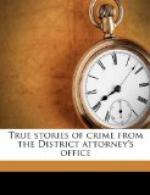[Illustration: First page of the “Black Hand” letter written by Strollo, and put in evidence at his trial, placing the murder of Torsielli upon members of that imaginary secret organization. This letter convicted him.]
It is clear from the letter that Strollo had formed a vague plan for his defence, which should, in part, consist of the claim that he, as well as Torsielli, had been marked for death by the Black Hand, and that while both had been induced to come to New York, the plans of the assassins had in his case miscarried.
The reader has already observed that purely for the purpose of securing his continued interest in the present narrative the writer has, as it were, told his story backward, reserving as long as possible the fact that the finding of the beloved Vito was a pure fiction invented by the murderer. At the trial, however, the jury listened breathlessly while bit by bit the whole pathetic story was painted before them, like a mosaic picture. They heard first the story of the mushroom digger, there of the expedition of Petrosini to Lambertville, of the identification of Torsielli’s body, of the elaborate fabrications of Strollo, and in due course, of the tell-tale letter in the murderer’s pocket. Gradually the true character of the defendant’s crime came over them and they turned from him in aversion. The natural climax in the evidence was Miss Phillip’s extraordinary identification of the defendant sitting at the bar as the man who had mailed upon the 26th of July, at the Lambertville post-office, the envelope purporting to come from Yonkers and containing the forged letter from the imaginary Vito.
Strollo remained almost to the last confident that he could never be convicted, but when his own letters in prison were introduced in evidence he turned ashen pale and stared fixedly at the judge. The jury deliberated but fifteen minutes, their functions consisting of but a single ballot, followed by a prayer for the wretched murderer’s soul. Then they filed slowly back and, in the waning light of the summer afternoon just one year after the murder, and at the precise hour at which Strollo had killed his victim, pronounced him guilty of murder in the first degree. In due course his conviction was sustained by the Court of Appeals, and on March 11th, 1908, he paid the penalty for his crime in the electric chair.



